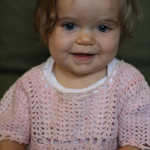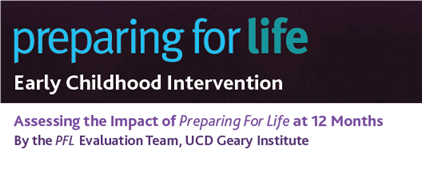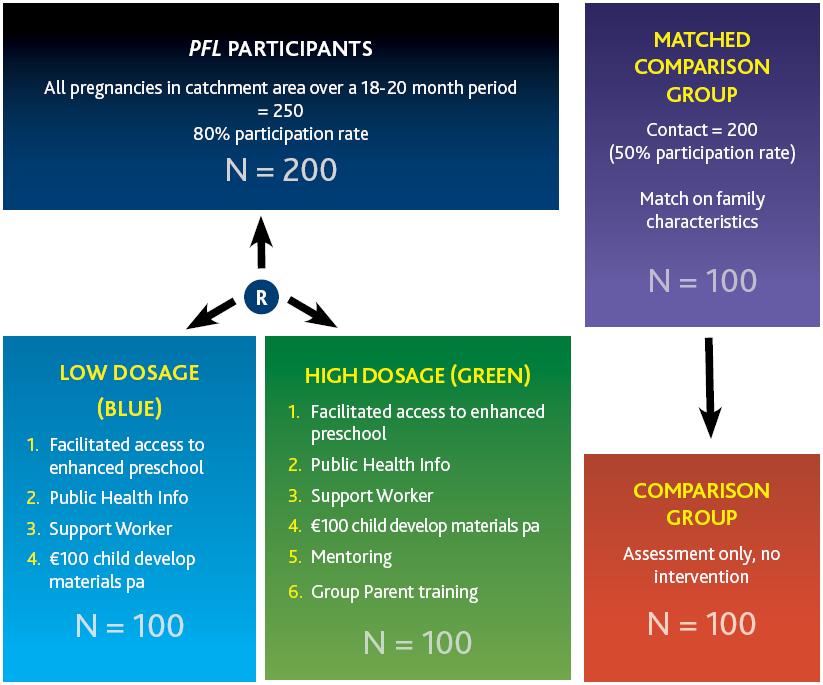12 Month Report
Further Information:
12 Month Report – Summary Version
| Introduction 12 month report |
 The intergenerational transmission of socioeconomic inequalities in children’s health and cognitive, behavioural, and emotional development emerge early and can persist through life (Najman et al., 2004; Shonkoff & Phillips, 2000).
The intergenerational transmission of socioeconomic inequalities in children’s health and cognitive, behavioural, and emotional development emerge early and can persist through life (Najman et al., 2004; Shonkoff & Phillips, 2000).
Evidence suggests that targeted, early intervention programmes aimed at disadvantaged children and their families are an effective means of reducing these inequalities.
Preparing for Life (PFL) is a prevention and early intervention programme which aims to improve the life outcomes of children and families living in North Dublin, Ireland. The programme is being evaluated by the UCD Geary Institute and this evaluation aims to provide evidence on the effectiveness of such early interventions. This chapter describes the objectives and theoretical rationale of the PFL Programme and Evaluation, as well as the aims and structure of the report.
| The PFL Evaluation |
| Recruitment & Baseline Analysis |
 In total, 233 pregnant women were recruited into the PFL Programme between January 2008 and August 2010. Randomisation resulted in 115 participants assigned to the high treatment group and 118 participants assigned to the low treatment group. In addition, 99 pregnant women were recruited into the comparison group. The population based recruitment rate was 52%. Baseline data, collected before the programme began, was available for 104 and 101 high and low PFL treatment group participants respectively, and 99 comparison group participants. Tests of baseline differences between the high and low PFL treatment groups found that the two groups did not statistically differ on 97% of the measures analysed, indicating that the randomisation process was successful. The aggregate PFL group and the LFP comparison group did not statistically differ on 75% of the measures; however, the comparison group was of a relatively higher socioeconomic status.
In total, 233 pregnant women were recruited into the PFL Programme between January 2008 and August 2010. Randomisation resulted in 115 participants assigned to the high treatment group and 118 participants assigned to the low treatment group. In addition, 99 pregnant women were recruited into the comparison group. The population based recruitment rate was 52%. Baseline data, collected before the programme began, was available for 104 and 101 high and low PFL treatment group participants respectively, and 99 comparison group participants. Tests of baseline differences between the high and low PFL treatment groups found that the two groups did not statistically differ on 97% of the measures analysed, indicating that the randomisation process was successful. The aggregate PFL group and the LFP comparison group did not statistically differ on 75% of the measures; however, the comparison group was of a relatively higher socioeconomic status.
| Six Month Report Summary |
 The six month evaluation of Preparing for Life suggests that the programme is progressing well. 257 six month interviews (nLow =90, nHigh =83, nLFP =84) were completed. As found in other studies of home visiting programmes, there were limited significant differences reported between the high and low PFL treatment groups (14%) at six months. Many of the relationships were in the hypothesized direction, with the high treatment group reporting somewhat better outcomes than the low treatment group. There were some significant findings in the domains of parenting, the quality of the home environment and social support across all groups, which correspond directly to information on the PFL Tip Sheets delivered to participants during this period.
The six month evaluation of Preparing for Life suggests that the programme is progressing well. 257 six month interviews (nLow =90, nHigh =83, nLFP =84) were completed. As found in other studies of home visiting programmes, there were limited significant differences reported between the high and low PFL treatment groups (14%) at six months. Many of the relationships were in the hypothesized direction, with the high treatment group reporting somewhat better outcomes than the low treatment group. There were some significant findings in the domains of parenting, the quality of the home environment and social support across all groups, which correspond directly to information on the PFL Tip Sheets delivered to participants during this period.
However, the programme had no significant impact on key factors such as pregnancy behaviour, infant birth weight, breastfeeding, and child development at six month. While attrition was low and participant satisfaction was high, the level of engagement was less than anticipated. Mothers with relatively higher cognitive resources received a greater number of home visits and may have benefited more from the programme than those with lower cognitive resources.
| Impact of PFL at 12 Months: Main Results |
 In total, 247 twelve month interviews (nLow = 82; nHigh = 83; nLFP = 83) were completed. The main results compared the twelve month outcomes of the high treatment group to the twelve month outcomes of the low treatment group across eight main domains: child development, child health, parenting, home environment and safety, maternal health and pregnancy, social support, childcare , household factors and socioeconomic status (SES), incorporating 147 outcome measures. Consistent with the programme evaluation literature, there were limited significant differences observed between the high and low treatment groups at twelve months. There were fewer significant findings in the hypothesized direction at twelve month, compared with six months, however this may be due to the differences in the measures included at each time point with the 8 domains.
In total, 247 twelve month interviews (nLow = 82; nHigh = 83; nLFP = 83) were completed. The main results compared the twelve month outcomes of the high treatment group to the twelve month outcomes of the low treatment group across eight main domains: child development, child health, parenting, home environment and safety, maternal health and pregnancy, social support, childcare , household factors and socioeconomic status (SES), incorporating 147 outcome measures. Consistent with the programme evaluation literature, there were limited significant differences observed between the high and low treatment groups at twelve months. There were fewer significant findings in the hypothesized direction at twelve month, compared with six months, however this may be due to the differences in the measures included at each time point with the 8 domains.
Specifically, children in the high treatment group compared to those in the low treatment group had higher livels of fine motor skills, less likely to be at risk of social and emotional difficulties, more appropriate eating patterns, had higher of immunization rates. Additionally, mothers in the high treatment group reprted being less likely to report drinking alcohol and more likely to meet their friends regularly, compared with mothers in the low treatment group. Of the 140 two-tailed individual outcomes analysed, there were significant differences between the high and low treatment groups on 11 measures (8%). There were no significant effects in the domains of parenting and home environment. The domains with the most positive effects were child development, child health, maternal health and well being and social support.
| Dynamic Analysis Results |
The dynamic analysis was conducted to assess change over time for measures included at multiple data collection time points. Three common instruments were administered at six and twelve months, three were administered at baseline and twelve months and one was administered at baseline, six and twelve months.
The results indicated that children in the high treatment group had significantly better fine motor skill development between six and twelve months, compared to those in the low treatment group. Additionally, children in the high treatment group were significantly less likely to experience parental oppression of their power and independence by twelve months than those in the low treatment group. There were no differences in the remaining 24 measures.
| Interactions and Sub-group Results |
 The interaction was conducted to determine whether the PFL programme had a varying impact on girls or boys, first time or non-first time mothers, lone or partnered parents, mothers with higher or lower cognitive resources, families with high or low familial risk and mothers with low or high emotional wellbeing. The results indicated that the programme may be particularly beneficial to partnered mothers, first time mothers and boys.
The interaction was conducted to determine whether the PFL programme had a varying impact on girls or boys, first time or non-first time mothers, lone or partnered parents, mothers with higher or lower cognitive resources, families with high or low familial risk and mothers with low or high emotional wellbeing. The results indicated that the programme may be particularly beneficial to partnered mothers, first time mothers and boys.
| Comparison Group Results |
The outcomes of the two PFL treatment groups were also compared to the matched comparison group. There were more significant differences in the outcomes of the high treatment group versus the comparison group (14%) than in the outcomes of the low treatment group versus the comparison group (9%).
These findings support the main results and suggest that the common programme components, such as the developmental and reading packs, may have an impact on all of those participating in the PFL programme.
| Attrition |
 15% of the sample officially dropped out of the programme between the baseline assessment and twelve months (High=20%, Low=14%, LFP=9%). 10% of the sample were classified as disengaged (High=9%, Low=15%, LFP=8%). In addition, the level of attrition between six and twelve months was extremely low (2 participants).Very few individual participant characteristics were associated with programme attrition and disengagement. Overall, there is weak evidence to suggest that there are systematic differences based on relative disadvantage between those who completed the twelve months survey and those who did not. However, there is no definite pattern as to whether more or less advantaged participants were more difficult to contact. Families in the high treatment group received an average of 21 home visits by the PFL mentors between programme intake and twelve months, with each visit lasting about one hour on average. The majority of participants reported meeting their mentor twice a month (61%). Few individual participant characteristics were associated with the frequency or duration of home visits. Findings suggest that mothers who joined the programme earlier in pregnancy and mothers with higher self-esteem were more likely to engage in the programme prenatally. Also, mothers with higher cognitive resources engaged in more home visits and had home visits of a longer duration.
15% of the sample officially dropped out of the programme between the baseline assessment and twelve months (High=20%, Low=14%, LFP=9%). 10% of the sample were classified as disengaged (High=9%, Low=15%, LFP=8%). In addition, the level of attrition between six and twelve months was extremely low (2 participants).Very few individual participant characteristics were associated with programme attrition and disengagement. Overall, there is weak evidence to suggest that there are systematic differences based on relative disadvantage between those who completed the twelve months survey and those who did not. However, there is no definite pattern as to whether more or less advantaged participants were more difficult to contact. Families in the high treatment group received an average of 21 home visits by the PFL mentors between programme intake and twelve months, with each visit lasting about one hour on average. The majority of participants reported meeting their mentor twice a month (61%). Few individual participant characteristics were associated with the frequency or duration of home visits. Findings suggest that mothers who joined the programme earlier in pregnancy and mothers with higher self-esteem were more likely to engage in the programme prenatally. Also, mothers with higher cognitive resources engaged in more home visits and had home visits of a longer duration.
| Dosage |
Families in the high treatment group received an average of 21 home visits by the PFL mentors between programme intake and twelve months, with each visit lasting about one hour on average. The majority of participants reported meeting their mentor twice a month (61%). Few individual participant characteristics were associated with the frequency or duration of home visits. Findings suggest that mothers who joined the programme earlier in pregnancy and mothers with higher self-esteem were more likely to engage in the programme prenatally. Also, mothers with higher cognitive resources engaged in more home visits and had home visits of a longer duration.
| Satisfaction |
Overall, participant satisfaction with the programme between six and twelve months was high. As expected, the high treatment group reported greater satisfaction with the programme than the low treatment group. Consistent with the six month findings, both groups were generally satisfied with the whole programme, their children’s progress and the type of help they receive from the programme. However, both groups reported being least satisfied with how the programme has improved relationships with their partner.
| Contamination |
 A contamination analysis was conducted to determine whether the low treatment group received all or part of the additional services designed for the high treatment group. These findings indicated that, although the potential for contamination was high,the level of contamination in the PFL programme up to twelve months was quite low and does not bias the twelve month results.
A contamination analysis was conducted to determine whether the low treatment group received all or part of the additional services designed for the high treatment group. These findings indicated that, although the potential for contamination was high,the level of contamination in the PFL programme up to twelve months was quite low and does not bias the twelve month results.
| Report Summary & Conclusions |
 The twelve month evaluation of Preparing for Life suggests that the programme is progressing well. Although, as found in other studies of home visiting programmes, there were limited significant differences reported between the high and low PFL treatment groups and the PFL treatment groups and the comparison group at twelve months. However, many of the relationships were in the hypothesized direction, with the high treatment group reporting somewhat better outcomes than the low treatment group. There were some significant findings in the domains of child development, child health, maternal health and wellbeing and social support. There were no significant differences in parenting, home environment and household factors and SES.
The twelve month evaluation of Preparing for Life suggests that the programme is progressing well. Although, as found in other studies of home visiting programmes, there were limited significant differences reported between the high and low PFL treatment groups and the PFL treatment groups and the comparison group at twelve months. However, many of the relationships were in the hypothesized direction, with the high treatment group reporting somewhat better outcomes than the low treatment group. There were some significant findings in the domains of child development, child health, maternal health and wellbeing and social support. There were no significant differences in parenting, home environment and household factors and SES.
In regards to implementation, PFL continues to enjoy relatively low attrition, while the level of engagement appears to be related to higher self esteem and higher cognitive resources. Overall, participant satisfaction was high and contamination levels continues to be low. These findings will be investigated in more detail in later reports.




